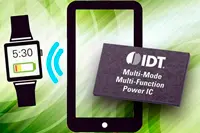Electronics News
Archive : 4 March 2015 год
 National Instruments has announced the PXIe-8880 controller. Based on the Intel Xeon processor and with a system bandwidth of 24Gbyte/s, the device is said to deliver breakthrough performance for computationally intensive and highly parallel applications, such as wireless test, semiconductor test and 5G prototyping
National Instruments has announced the PXIe-8880 controller. Based on the Intel Xeon processor and with a system bandwidth of 24Gbyte/s, the device is said to deliver breakthrough performance for computationally intensive and highly parallel applications, such as wireless test, semiconductor test and 5G prototyping
National Instruments has announced the PXIe-8880 controller. Based on the Intel Xeon processor and with a system bandwidth of 24Gbyte/s, the device is said to deliver breakthrough performance for computationally intensive and highly parallel applications, such as wireless test, semiconductor test and 5G prototyping
The embedded controller features an eight core Xeon, up to 24Gbyte of DDR4 memory and 24 lanes of PCI Express Gen 3 connectivity to the backplane. This is said by the company to provide twice the processing power and bandwidth than previous generation controllers.
NI has also introduced the PXIe-1085 chassis; an 18 slot chassis with eight PCIe Gen 3 lanes per slot.
Author
Graham Pitcher
Source: www.newelectronics.co.uk
 Computer scientists from Saarbrücken University, in collaboration with researchers from Carnegie Mellon University in the US, have developed touch sensitive flexible silicone stickers featuring electrically conducting sensors. The stickers, which can be worn on the skin, can act as controllers for mobile devices.
Computer scientists from Saarbrücken University, in collaboration with researchers from Carnegie Mellon University in the US, have developed touch sensitive flexible silicone stickers featuring electrically conducting sensors. The stickers, which can be worn on the skin, can act as controllers for mobile devices.
"The stickers allow us to enlarge the input space accessible to the user as they can be attached practically anywhere on the body," said Martin Weigel, one of the Saarland researchers.
Silicone allows the sensor patches to be flexible and stretchable. "This makes them easier to use in an everyday environment," said Jürgen Steimle, head of Saarland's Embodied Interaction Group. "The music player can simply be rolled up and put in a pocket. They are also skin friendly and users can decide where they want to position the sensor patch and how long they want to wear it."
Users can also design their own patches; all that is needed is a simple graphics program.
While the sensors are currently connected using a cable, integrating chips into them may allow the patches to communicate wirelessly.
Author
Graham Pitcher
Source: www.newelectronics.co.uk
 IDT has unveiled Wireless PowerShare technology at Mobile World Congress. The innovation is said to allow one mobile device to be charged wirelessly from another.
IDT has unveiled Wireless PowerShare technology at Mobile World Congress. The innovation is said to allow one mobile device to be charged wirelessly from another.
The multimode, multifunction chip is a receiver and transmitter that is said to support all major wireless power standards for magnetic resonance and magnetic induction charging.
The device, a member of IDT's P9700 series, works with the three leading standards: the Alliance for Wireless Power (A4WP); the Power Matters Alliance (PMA); and the Wireless Power Consortium. It delivers from 5 ato 10W and integrates a proprietary mode that provides flexibility for OEMs.
"Consumers have been asking why, with all the remarkable advances in electronics, we remain tethered by power cords," said Arman Naghavi, IDT's vice president of analogue power technology. "Wireless PowerShare technology is a big leap in the right direction, allowing devices to charge one another, free from the tangle of wires."
Author
Graham Pitcher
Source: www.newelectronics.co.uk
 Raytheon UK is collaborating in a project intended to provide a more efficient device to protect aircraft electronics and wiring against lightning strikes.
Raytheon UK is collaborating in a project intended to provide a more efficient device to protect aircraft electronics and wiring against lightning strikes.
The project – led by Controls and Data Services – also includes Newcastle University as the design authority and TT Electronics Semelab. As part of its work, the team is exploring whether Raytheon's and Newcastle University's high temperature silicon carbide technology can be used to make current limiting diodes (CLDs); a lightning protection device which is intended to reduce the amount of electrical energy traditional suppressors have to deal with during a lightning strike.
During electrical storms, lightning paths travel cloud to ground or cloud to cloud; sometimes, aircraft in flight can form part of the path. The outer skin of the aircraft, traditionally aluminium, does much to accommodate the lightning's path, while voltage 'surge suppression' devices are used to protect aircraft electronics.
"With composite materials replacing metallic components and skin materials, the reduced electrical screening in airframes is forcing a rethink of lightning protection architectures," said John Kennedy, head of Raytheon UK's Integrated Power Solutions. "CLDs will essentially absorb much of the electrical energy that the dampening device would otherwise have to channel during a lightning strike."
At the moment, Newcastle University is conducting electrical characterisation tests while TT Electronics Semelab is developing the CLD packaging. The two phase project, funded by Innovate UK, is expected to be completed by late 2015.
Author
Graham Pitcher
Source: www.newelectronics.co.uk

